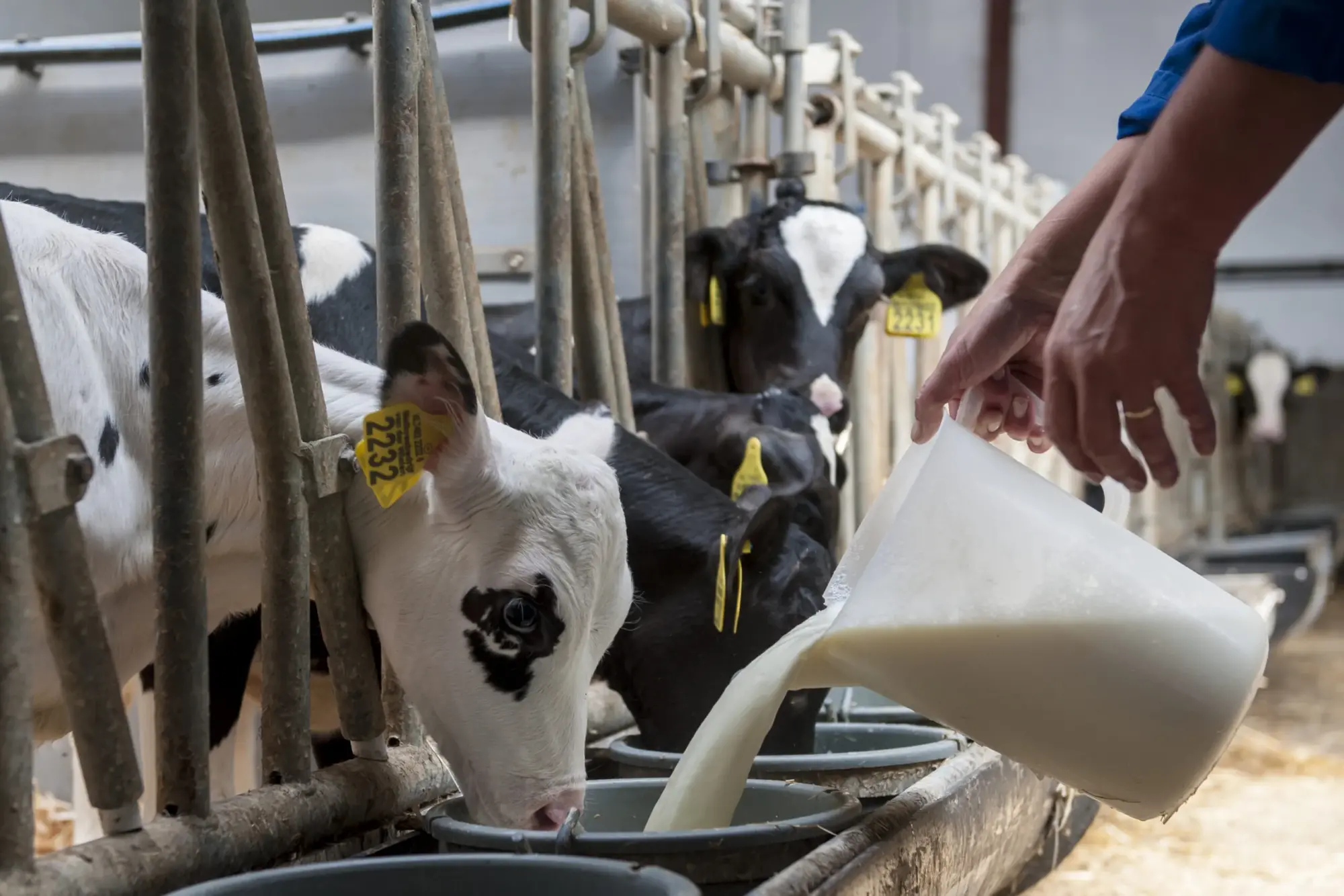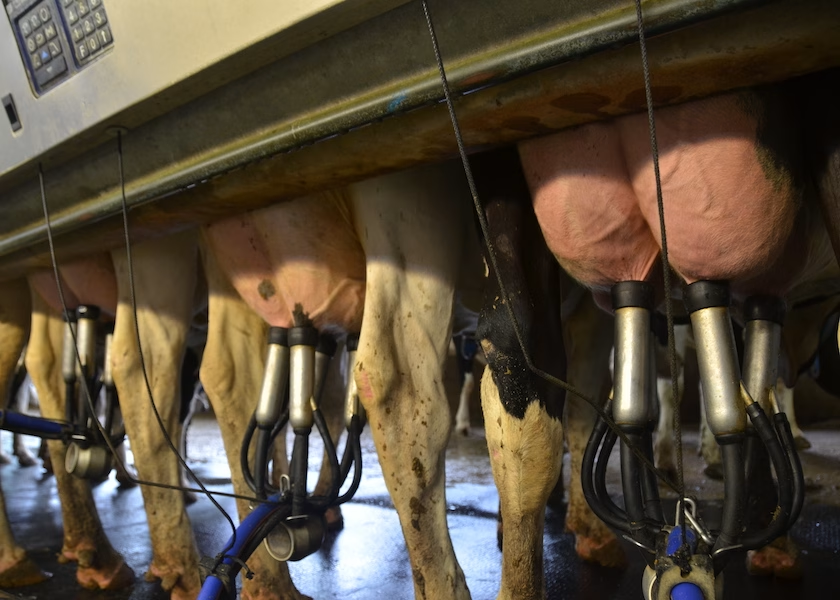Investigate how milk replacer composition influences calf gut health. Do omega fatty acid ratios and fat sources in milk replacers impact your calves’ growth and digestion?

As a dairy farmer, you understand that your calves’ food dramatically influences their future health and production. The ongoing debate between milk replacers and whole milk for calf feeding is not just important; it’s crucial, especially when considering the implications for gut health. While whole milk has always been the preferred option, the increasing focus on the composition of milk replacers and their potential gastrointestinal effects is a significant development. Shannon Chick of Virginia Tech has illuminated how the fatty acids in milk replacers, particularly their ratio, influence immunological responses and inflammation. This understanding is essential; it engages, draws you into the conversation, and enables you to make informed feeding choices. Ultimately, the goal is to grow healthier, more productive calves, benefiting your dairy company.
The Evolution of Calf Nutrition: Whole Milk Versus Milk Replacers
Whole milk has long been the staple of calves’ diet in the dairy business. This traditional approach provides a rich supply of nutrients and closely mimics calves’ natural eating habits. Dairy producers have long relied on whole milk for its balanced mix of lipids, proteins, and other critical ingredients that support development and health. However, challenges such as unpredictable milk output, high costs, and the risk of disease transmission have spurred the search for alternatives. This quest is not just a response to obstacles; it’s an opportunity for growth and health in your calves, giving you reason to be hopeful about the future.
This is when milk replacers enter the picture. They are developed to imitate the nutritional profile of whole milk, making them a simple and frequently less expensive option for feeding calves. Despite their advantages, the composition of milk replacers is still being debated. Unlike whole milk, milk replacers may include many constituents, notably fat and protein sources and ratios.
The ongoing debate over milk replacer composition is not just a matter of opinion; it’s a significant factor influencing calf health, particularly gut health. As dairy farmers and industry specialists, we play a crucial role in this debate. Our understanding and informed choices can profoundly impact calves’ digestive development, immunological function, and overall growth. This understanding is not just essential; it’s empowering. It’s a commitment to making informed choices to enhance calf-rearing techniques and, ultimately, dairy farm output.
Unpacking the Science: Shannon Chick’s Insights on Milk Replacer Composition and Calf Gut Health
Shannon Chick of Virginia Tech has studied the composition of milk replacer and its impact on calf gastrointestinal health, as reported in the Virginia Dairy Pipeline newsletter. Chick evaluated numerous significant studies that looked at the ratio of omega-6 (n-6) to omega-3 (n-3) fatty acids in milk replacer vs whole milk, highlighting how these fatty acids affect inflammatory responses and tight junction function in calves’ jejunum and ileum. Chick also reviewed studies that discriminated between milk replacers manufactured from animal and vegetable lipids and a mixture of them and evaluated their effects on growth, intake, digestibility, and gastrointestinal permeability. Although conclusive results about the ideal milk replacer composition for calves are yet unknown, Chick emphasized the relevance of these elements in continuing debates within the dairy industry.
The Crucial Role of Omega-6 to Omega-3 Ratios in Calf Gut Health
One of the critical points raised in Chick’s analysis is the ratio of omega-6 to omega-3 fatty acids in milk replacer. Several studies have examined these ratios and found a considerable difference between the n-6:n-3 ratios in whole milk and those in commercial milk replacers. For example, although whole milk has a balanced ratio of about 5:1, many milk replacers have substantially greater ratios, sometimes exceeding 35:1 or even 40.6:1. This distinction highlights the significance of this ratio in the current argument.
The increased predominance of omega-6 fatty acids is especially relevant since they act as precursors to pro-inflammatory chemicals in the immune system. Elevated quantities of these fatty acids might cause an inflammatory response, jeopardizing gut health. Omega-3 fatty acids, on the other hand, are recognized for their anti-inflammatory properties, which may benefit gastrointestinal health and immune function in general.
According to Chick, research in the Netherlands reveals the influence of altering these ratios in milk replacers. Calves given a diet with a reduced n-6:n-3 ratio of 6.5:1 showed improved function of tight junctions in the jejunum and ileum, which are essential for nutrient absorption and gut barrier function. This indicates that a balanced or lowered n-6:n-3 ratio may strengthen the gut lining, boosting nutritional absorption and reducing the risk of gastrointestinal problems.
Despite these positive results on tight junction function, total gastrointestinal permeability remained constant. This underscores the complexities of dietary fat content and its varying impacts on calf health. While the omega-6 to omega-3 fatty acid ratio is essential, it is just one part of the complex picture of calf nutrition and gut health.
Decoding Fatty Acid Ratios: The Netherlands Study on Calf Gut Health
A research team in the Netherlands study evaluated milk replacers with varying ratios of omega-6 to omega-3 fatty acids, particularly a ratio of 40.6 to 1 against 6.5 to 1. The researchers sought to understand how these ratios affected calves’ gastrointestinal health. Notably, the research discovered that decreasing the ratio of n-6 to n-3 fatty acids improved tight junction function in the jejunum and ileum of calves, as seen by increased n-3 concentration in both tissues. However, it is essential to note that despite these alterations, gastrointestinal permeability remained unchanged by the fatty acid ratio adjustment.
Examining Fat Sources in Milk Replacers: Impacts on Calf Gut Health and Development
The content of lipids in milk replacers is an essential factor that determines calf gut health and growth. Whole milk fats have a unique structure designed by nature to aid healthy development and digestion in calves. These naturally occurring lipids are predominantly triglycerides, with a well-balanced fatty acid composition that promotes efficient nutrient absorption and utilization.
Alternative fat sources, such as animal fats, vegetable fats, or a combination of the two, have structural differences that might disrupt these processes. Animal fats have a fatty acid content similar to that of whole milk. Still, their molecular structure differs, which may impact calves’ ability to ingest and metabolize these fats. While abundant and inexpensive, vegetable fats provide a unique set of issues. Their fatty acid chains are usually longer and less saturated than those found in animal fats or whole milk, which may impede digestion and affect lipid metabolism.
Such variations in fat structure may cause various problems, including irregular development rates, digestive inefficiencies, and changes in gastrointestinal permeability. The study’s results in the Netherlands highlight that, although growth and total-tract digestibility may be unaffected, different fat sources might impact specific physiological processes, such as abomasal emptying. This emphasizes the need to carefully choose fat sources for milk replacers that closely mirror the natural composition of whole milk to maintain optimum gut health and development in dairy calves.
Abomasal Emptying: A Critical Factor Influenced by Milk Replacer Fat Sources
When evaluating the Dutch study, it is clear that the composition of milk replacer, whether derived from animal fats, vegetable fats, or a combination of the two, had no significant effects on calf growth, milk replacer intake, total-tract digestibility, or gastrointestinal permeability. Surprisingly, the variable that did elicit a reaction was abomasal emptying, with a significant difference detected with vegetable-derived lipids. These data indicate that although the fat source in milk replacers has no significant effect on primary growth and digestive parameters in calves, it does change the pace at which food is digested in the abomasum. This component may significantly affect calf feeding practices and general health.
Critical Insights for Dairy Farmers: Navigating Milk Replacer Composition for Optimal Calf Health
These studies emphasize the importance of examining milk replacer composition when determining calves’ feeding choices. While whole milk is still a traditional and popular choice owing to its natural, nutritious balance, milk replacers provide a practical alternative that can be adjusted to a herd’s unique requirements. However, differences in fatty acid ratios, notably the omega-6 to omega-3 ratio and the source of lipids utilized in milk replacers, show that not all are equal.
Dairy producers must evaluate how these elements affect calf growth, gastrointestinal health, and general development. For example, understanding how various fat sources influence abomasal emptying might affect a calf’s digestive efficiency and food intake. Furthermore, omega-6 to omega-3 fatty acids must be carefully monitored, as an uneven ratio may result in less optimum immunological and inflammatory responses in calves.
Given these results, farmers must consider alternatives and consult nutritionists or veterinarians to choose the best milk replacer for their calves. Selecting the appropriate milk replacer demands a detailed study of its nutritional makeup and possible effects on calf health, as picking a formula for human newborns does. Farmers may enhance calf health, develop more robust immune systems, and increase overall output by carefully choosing a milk replacer tailored to their herd’s needs.
The Bottom Line
Exploring the complexities of calf nutrition and milk replacers indicates that decision-making goes beyond popular understanding. Dairy producers must examine milk replacer compositions with a critical eye, notably the omega-6 to omega-3 fatty acid ratios and the source of their fat content. Modifying these ratios may help calves maintain intestinal integrity. Although the difference between animal and vegetable lipids may not significantly influence growth or overall digestibility, it can alter essential processes such as abomasal emptying. Making educated, research-backed judgments is critical to determining the best milk replacer for your calf herds. Your precise attention and adaptability might be essential to future success.
Key Takeaways:
- Whole milk has a significantly different omega-6 to omega-3 fatty acid ratio compared to some milk replacers, which may impact inflammatory responses in calves.
- Research indicates that adjusting the fatty acid ratios in milk replacers can influence tight junction function in the calf’s gut, although overall gastrointestinal permeability may remain unchanged.
- Different fat sources in milk replacers—animal fats versus vegetable fats—have varied impacts on calf health. They affect abomasal emptying without altering growth or digestibility.
- No single milk replacer formula has been proven superior, but understanding their compositions can guide better feeding decisions on the farm.
- Farmers must weigh multiple factors, including fatty acid composition and fat sources, to ensure optimal calf development and gut health.
Summary:
The debate between milk replacers and whole milk for calf feeding is crucial, especially regarding gut health. Whole milk is a staple in dairy, providing a rich supply of nutrients and closely mimicking calves’ natural eating habits. However, challenges such as unpredictable milk output, high costs, and the risk of disease transmission have spurred the search for alternatives. Milk replacers are developed to imitate the nutritional profile of whole milk, making them a simple and often less expensive option for feeding calves. The composition of milk replacers is still being debated, with many constituents, including fat and protein sources and ratios. Understanding and informed choices can profoundly impact calves’ digestive development, immunological function, and overall growth. Shannon Chick of Virginia Tech has studied the composition of milk replacers and their impact on calf gastrointestinal health, focusing on the ratio of omega-6 (n-6) to omega-3 (n-3) fatty acids. A balanced or lowered n-6:n-3 ratio may strengthen the gut lining, boosting nutritional absorption and reducing the risk of gastrointestinal problems.












